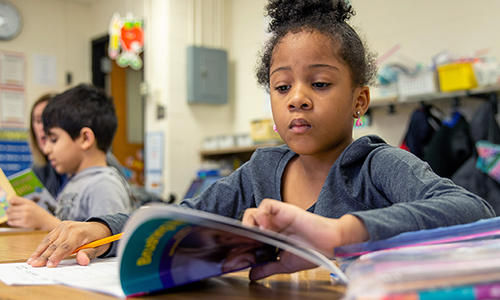
Dyslexia is a widely recognized learning difficulty, yet research shows misconceptions are widespread, not only among the general public but also among educators, school psychologists, reading specialists, and even college professors. This complicates the path to understanding the most widely identified learning disability and getting the right intervention and support to students.
As we observe Dyslexia Awareness Month, it’s essential to dispel these myths, offer clarity through research-backed models, and emphasize the importance of early screening and targeted intervention. By fostering a deeper understanding of what dyslexia is, educators and administrators can enable students to understand their difficulties and achieve their full potential.
Common misconceptions about dyslexia
While completing my doctorate, I researched how best to help dispel misconceptions about dyslexia among educators. Studies from the field of conceptual change, a subset of the field of learning science, show that dispelling misinformation can work better to improve long-term understanding than just giving people accurate information. To do this, we must first name and normalize myths before attempting to inform people about the facts.
Despite increased awareness, myths about dyslexia continue to thrive. One of the most common misconceptions is that dyslexia means people see letters or words backward. This myth has been perpetuated in pop culture, but dyslexia is not a visual problem; instead, most plainly, it’s an increased difficulty with learning to read and spell words.
Another myth is that dyslexia is tied to intelligence. Some assume that if a child is smart, they can’t possibly have dyslexia, or that struggling with reading equates to a lack of intelligence. Some people believe you have to find a discrepancy between intelligence scores and reading scores. Neither of these is true.
Dyslexia describes a difficulty with learning to decode words fluently and trouble with spelling. There is no need to find any discrepancies in intelligence, strengths, or weaknesses to identify a student with dyslexia. Instead, the best practice for identification is a low response to generally effective reading intervention, combined with low achievement in reading that isn’t accounted for by other disabilities, like an intellectual disability or the need for glasses.
A path to clearer understanding: The Simple View of Reading
To understand dyslexia better, it’s helpful to look through the lens of the Simple View of Reading. According to this model, reading is composed of two essential components: word recognition (decoding) and language comprehension. While both components are crucial for successful reading, when we use the term “dyslexia,” we are only referring to the word-recognition component; that is, we’re referring only to decoding.

This difficulty with word recognition is the defining factor of the term “dyslexia,” which the International Dyslexia Association (IDA) defines as “a specific learning disability…characterized by difficulties with accurate and/or fluent word recognition and by poor spelling and decoding abilities.”
This doesn’t mean students with dyslexia may also have a difficulty with language comprehension; as we know from research, about 50% of children with dyslexia also have developmental language disorder, or DLD. This fact helps educational leaders know to always assess both components separately, rather than just assessing reading comprehension, when doing a comprehensive assessment for dyslexia.
DLD and dyslexia: A connection through the Simple View of Reading
DLD can co-occur with dyslexia, further complicating reading and learning. While dyslexia affects word recognition, DLD impacts a child’s ability to understand and use language, influencing how they comprehend what they hear and read. For more on this, watch Tiffany Hogan, a leading researcher in dyslexia and DLD, as she emphasizes the importance of recognizing DLD as a significant factor in reading development.
Understanding DLD through the lens of the Simple View of Reading clarifies how both difficulties affect reading in unique ways: dyslexia impacts word recognition and DLD affects language comprehension. To learn more about DLD, visit DLDandMe.org for a wealth of resources. Understanding both dyslexia and DLD can help educators align interventions to student need and enable all students to learn to become readers.
Early screening for at-risk children
Given the overlap between dyslexia and DLD, early screening is crucial for identifying students who are at risk. Identifying which students are having the greatest difficulties allows educators to target word recognition, or decoding, skills for students at risk of later being identified with dyslexia; support language comprehension for those at risk of later being identified with DLD; and provide a double dose of intervention for students who have difficulties in both areas. Early intervention is key to helping children succeed academically and avoid long-term struggles with reading.
Our K–5 reading assessment, MAP® Reading Fluency™, can help with early identification of students in need of interventions, including those at-risk of later being identified with dyslexia and/or DLD. To learn more, download our MAP Reading Fluency Dyslexia Screener fact sheet and see our YouTube channel.
Early intervention: Aligning interventions with student needs
Remember, after screening identifies students who are at risk of not meeting grade-level reading benchmarks, the next step is notto identify students with dyslexia or DLD; it is to ensure that students who need intervention are given targeted lessons that are aligned with their specific areas of difficulty.
Dyslexia interventions should focus on word recognition—whether the student needs fluency with phonics skills, multisyllabic words, or passages of text—using structured approaches that are explicit and systematic. In the early grades, this may look like introducing a phonics skill, working with word chains, and reading decodable texts. In the later grades, this may look like teaching flexible division routines, morphology-based reading and spelling patterns, and text-level fluency work.
For students with DLD, interventions should include strategies that focus on both vocabulary and morphology and reading comprehension. The key is that the interventions are tailored to the child’s individual difficulties, ensuring targeted support that meets the specific areas of need. If the child has more difficulty with learning new vocabulary and connecting concepts, preteaching science and social studies content could be impactful. Integrating writing should also be considered for students with DLD to connect explicitly taught skills in grammar, vocabulary, and content knowledge.
Practical tips for educators and administrators
Whether you’re a classroom teacher or school or district administrator, the following can help you serve the needs of students with dyslexia:
- Implement early screening. Identifying student difficulties early ensures interventions can begin before reading difficulties escalate. Prioritize universal screening for dyslexia and DLD during the early grades. Ensure your screener is brief and well-researched. MAP Reading Fluency is an excellent choice.
- Adopt evidence-based interventions. Use interventions grounded in research and tailored to address a targeted student need in either word recognition, language comprehension, or both.
- Invest in professional learning. Continuous professional learning is essential for educators to stay current with research and best practices for understanding and teaching students with dyslexia and DLD. Professional learning opportunities, whether virtual or in person, equip educators to implement effective interventions in their classrooms. Learn more about our offerings on our website.
Bonus: Watch the second part of our interview with Tiffany Hogan
To deepen your understanding of DLD and its connection to dyslexia, watch the second part of our interview with Tiffany Hogan. In this video, she shares valuable insights and strategies for supporting children at risk for or with DLD and dyslexia.





